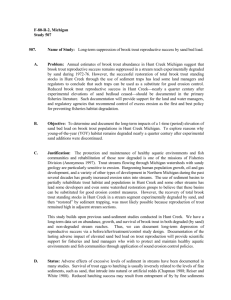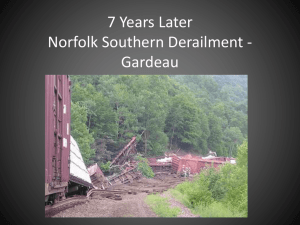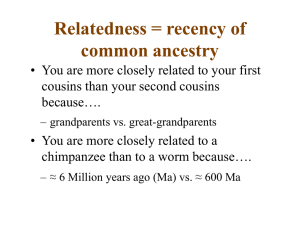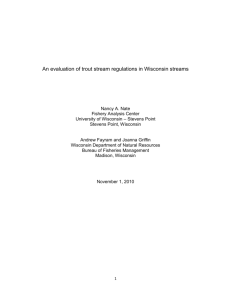Word Document, 10 pages (3.9 mb
advertisement
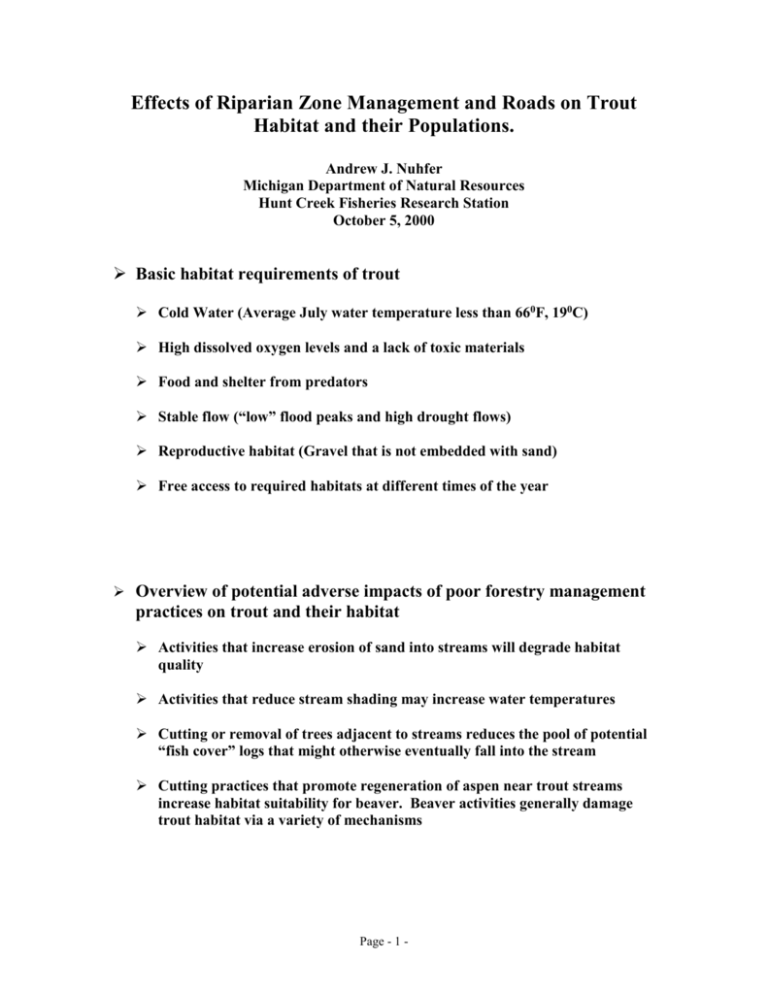
Effects of Riparian Zone Management and Roads on Trout Habitat and their Populations. Andrew J. Nuhfer Michigan Department of Natural Resources Hunt Creek Fisheries Research Station October 5, 2000 Basic habitat requirements of trout Cold Water (Average July water temperature less than 660F, 190C) High dissolved oxygen levels and a lack of toxic materials Food and shelter from predators Stable flow (“low” flood peaks and high drought flows) Reproductive habitat (Gravel that is not embedded with sand) Free access to required habitats at different times of the year Overview of potential adverse impacts of poor forestry management practices on trout and their habitat Activities that increase erosion of sand into streams will degrade habitat quality Activities that reduce stream shading may increase water temperatures Cutting or removal of trees adjacent to streams reduces the pool of potential “fish cover” logs that might otherwise eventually fall into the stream Cutting practices that promote regeneration of aspen near trout streams increase habitat suitability for beaver. Beaver activities generally damage trout habitat via a variety of mechanisms Page - 1 - Excess erosion of sand into streams is arguably the most serious cause of reduced trout habitat quality in the majority of Michigan trout streams. Some adverse effects are listed below: Sand reduces availability of trout cover by filling pools and burying logs and cobble. Loss of these “hard” substrates also reduces invertebrate food production. Sand covers or embeds gravels used by trout for spawning. Gravel is also a more productive habitat for invertebrates that are used by trout as food. Sand smoothes the stream bottom causing increased water velocities and hence higher energetic costs for fish. Streams with excess sand bedload become wider and shallower and hence warmer **Once a stream has been damaged by excess sediment it may take decades or centuries for it to recover because sand is transported slowly in low gradient systems. There is convincing empirical evidence that excess sand in trout streams can have profound adverse impacts on trout habitat quality. Several long-term studies conducted by Gaylord Alexander of MDNR and Ed Hansen of the U.S.F.S established a clear negative relationship between sediment concentration and carrying capacity for trout in two trout streams. The design and findings from the Hunt Creek study are discussed below. Page - 2 - Experimental Design of the Hunt Creek Sediment study A classic Before/After/Treatment/Control design was used Data on trout populations, physical habitat, and invertebrate abundance was collected from treatment and reference zones for over 2 decades. Sand concentration was artificially elevated in the treatment zone to simulate “real world” impacts of excess sand erosion. Experimental Schedule Pretreatment data collection (1967-71) Treatment (1972-76): Sand bed-load was increased from 20 ppm to 80-110 ppm (This is a typical sand bedload concentration in streams degraded by erosion sources such as pipelines and roads) Natural Recovery (1977-81): Sand additions ceased while monitoring of habitat, fish and invertebrates continued. Accelerated recovery (1982-95): Sediment removal was accelerated by instream sand traps. Downstream Bulkhead Sand trapped (1982-95) Treatment (1 mile) Sand added (1972-76) Diagram of Hunt Creek Study Area Control (1 mile) Upstream Bulkhead Page - 3 - Pertinent findings on total trout standing stocks: Sand additions caused their greatest damage over 5 years after they began. Natural recovery rates are very slow because sand transport is slow Sand traps were effective in restoring standing stocks (However, we can not afford such an intensive sand removal effort over a broad geographic area) Depression and recovery of fall biomass of brook trout in Hunt Creek, MI, following sedimentation Kilograms per hectare Treatment Control 140 120 100 80 60 40 20 50 55 60 65 70 75 80 85 90 95 Year Note that fall standing stock of trout in the treatment and control sections were synchronous and similar in size prior to experimental elevation of sand bedload. Stream was open to fishing prior to 1965 (that is why biomass was lower then) During the treatment and natural recovery period carrying capacity of the treatment zone was much lower. Reduced standing stocks in the control zone during part of the experimental period are believed to be due, in part, to reduced emigration from the degraded treatment zone Hence, excess sedimentation can reduce fish populations even in stream segments located upstream of an erosion source Page - 4 - A second long-term experiment (10 years) on effects of sand was conducted in Poplar Creek. In that study, digging sand traps reduced the existing sand bedload. The 2 data points plotted for each stream are the averages for the pretreatment and post-treatment years. In Poplar Creek sand bedload was decreased and the trout population increased. In Hunt Creek sand bedload was initially increased resulting in a depression of trout production. When sand bedload was reduced trout production was increased. Relationship of fall brook trout standing crop and sand bed-load concentration in Hunt and Poplar creeks Pounds of trout/acre (fall) Poplar Creek Hunt Creek 120 100 80 60 40 20 0 0 20 40 60 80 Sediment concentration (ppm) Page - 5 - 100 120 The bad news is that even an intensive sediment removal program in Hunt Creek did not restore reproductive habitat. Total standing stocks were restored because habitat for larger fish improved and because the Hunt Creek system of tributaries produced enough young to stock the stream. THE LESSON FOR LAND MANAGERS IS IT IS FAR BETTER NOT TO DAMAGE THE HABITAT IN FIRST PLACE BECAUSE WE CAN NOT COMPLETELY FIX IT. Fall numbers of young-of-the-year brook trout in Hunt Creek before and after excess sedimentation Numbers per hectare Treatment Control 4500 4000 3500 3000 2500 2000 1500 1000 500 0 Before Sed. (1967-71) During Sed. Before traps After traps (1972-75) (1976-81) (1982-97) We can not fully restore the habitat in decades! Forestry BMP’s that reduce sedimentation Water diversion devices on roads (broad base dips, water bars, diversion ditches etc. Drain water into buffer strips or vegetation. Construct sumps/settling basins. Restrict use of roads during spring breakup Close abandoned and low-use roads Minimize the number of water crossings for skid trails and roads Do not log up to the stream! Page - 6 - Functions of Large Wood Debris (LWD) in streams It slows export of organic material so that stream biota can process and assimilate it It is a source of organic material (energy) It increases habitat diversity and promotes formation of pools and undercut banks It reduces or prevents loss of gravel from high gradient streams It can protect eroding banks Ways that LWD benefits fish Protection from predators (higher survival) It reduces competition by providing visual isolation Provides refuge from high-velocity water (lowers energy requirements) Pools created by LWD are good fish habitat It provides stable attachment sites for an array of fish food organisms It increases use of spawning gravel (predator avoidance behavior) What foresters could do, or not do… Do not remove ANY large trees, whether dead or alive, that are adjacent to streams. Promote growth of large trees in riparian zones. Page - 7 - BEAVERS AND FOREST MANAGEMENT Cutting practices that promote growth of aspen adjacent to trout streams enhances habitat suitability for beaver Beaver dams, in turn, may have profound adverse effects on trout habitat quality, particularly when large numbers of dams are built on one coldwater river system Dams generally increase water temperatures Dams are barriers to fish movement to spawning, nursery, and rearing habitat. They may block movement to thermal refuges and wintering habitat. Beaver activities increase sedimentation. Although beaver ponds also trap sediment, it is often released when dams fail or when new channels are cut around the edges of the dams. Beaver cut trees adjacent to streams thereby decreasing shading Non-trout species typically become more abundant Water chemistry may be altered. Some beaver ponds become anoxic in winter Impoundments create a need for cool thermal refugia (for trout) and the dams, in turn, inhibit or block access to these refugia Impoundments reduce stream flow via increased evaporation and transpiration Page - 8 - Aspen management adjacent to small coldwater tributaries, which promotes beaver dam building, may have bigger impacts than similar management along larger streams (see graphic below). Average July maximum temperature above and below a beaver impoundment on a small tributary to Hunt Creek. Average based on weekly max/min temperatures. 1987 1986 1984 1980 1979 Outlet 1978 1977 1976 1975 1974 1973 85 80 75 70 65 60 55 50 45 40 1972 Inlet Long-term solutions Manage for non-aspen species in wide (up to 100 yards on both sides of the stream) riparian zones along cold-water streams Manage for aspen along warmwater streams to achieve objectives for species such as beaver, woodcock, waterfowl, herpetofauna, etc. Recognize that we can not create new trout streams where geologic and hydrologic conditions do not generate “cold” flowing streams. We can create or promote impoundments on “warmwater” systems Other beaver habitat management considerations There are many non-trout streams in Michigan where management of riparian zones for aspen may be appropriate (See the Inland Trout and Salmon Guide for maps showing the locations of trout streams) Beavers rarely dam large rivers. Therefore, management to promote aspen in riparian corridors of large rivers is not as likely to adversely affect trout Page - 9 - Summary 1. Excess sedimentation in streams is probably the most significant cause of fish habitat degradation in northern Michigan. Use all feasible means to control erosion into streams. 2. Once the stream habitat is damaged it may be difficult or impossible to restore it within our lifetimes. Thus, the best approach is to prevent the sediment from getting to the stream in the first place. 3. Large wood is an integral part of proper stream ecosystem function. Promote growth and retention of large trees in wide riparian corridors to enhance fisheries habitat 4. Beaver can cause great harm to trout streams. Discourage aspen in wide corridors along trout streams. Manage for aspen and beaver along warmwater streams. Page - 10 -


